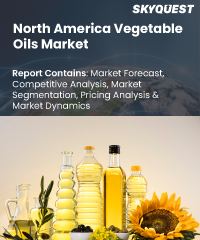
Report ID: SQMIR30H2150

Report ID:
SQMIR30H2150 |
Region:
Regional |
Published Date: July, 2001
Pages:
223
|
Tables:
133 |
Figures:
77
North America Vegetable Oils Market size was valued at USD 8.1 billion in 2019 and is poised to grow from USD 8.64 billion in 2023 to USD 13.65 billion by 2031, growing at a CAGR of 6.7% in the forecast period (2024-2031).
Demand for edible healthy oils sourced naturally is boosting the demand for vegetable oils in the market. Rapid growth of the processed food industry will further boost demand for them during the forecast period.
Palm oil sector holds 29.6% of market share in the market and is likely to stay ahead in the competition due to its wide availability and low cost. Consumers are increasingly demanding palm oil due to these factors.
Soybean oil is also likely to gain popularity due to its widespread usage in the processed food industry. It finds extensive application due to its ability to emulsify and bland flavor.
Increasing awareness about consumption of unrefined and saturated fat from animal sources is encouraging consumers to shift towards vegetable oils. Oil processing industries in Mexico and Canada are further boosting the market growth.
Malaysia and Indonesia remain two top exporters of vegetable oils and are expected to rise by 1.4% and 1.8% respectively. Malaysia exports about 80% of its output and Indonesia exports about 70% of its vegetable oils. Argentina, which also exports more than two-thirds of the domestically produced vegetable oil, is followed by Indonesia and Malaysia.
North America Vegetable Oils Market is poised to grow at a sustainable CAGR for the next forecast year.
Our industry expert will work with you to provide you with customized data in a short amount of time.
REQUEST FREE CUSTOMIZATIONNorth America Vegetable Oils Market size was valued at USD 8.1 billion in 2019 and is poised to grow from USD 8.64 billion in 2023 to USD 13.65 billion by 2031, growing at a CAGR of 6.7% in the forecast period (2024-2031).
Want to customize this report? This report can be personalized according to your needs. Our analysts and industry experts will work directly with you to understand your requirements and provide you with customized data in a short amount of time. We offer $1000 worth of FREE customization at the time of purchase.

Report ID: SQMIR30H2150